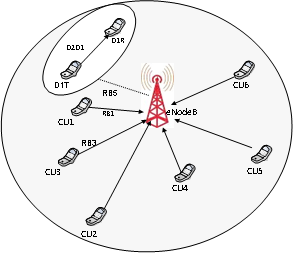Resource Allocation and Mode Selection in 5G Networks Based on Energy Efficient Game Theory Approach
Main Article Content
Abstract
With the advent of next-generation cellular networks, energy efficiency is becoming increasingly important. To tackle this issue, this paper investigates energy efficiency in D2D-enabled heterogeneous cellular networks. Boosting the longterm energy efficiency of wireless 5G communication networks is being explored through mode selection and resource allocation. The study proposed a three-stage process for energy-efficient mode selection and resource allocation. The process starts with cellular users who switch to D2D emitting a beacon and cellular users within close proximity reacting to it. A proposed auction mechanism will be enacted inside the group in the second state ( in this paper, the group size will be four). Next, each cellular user was classified according to SINR values, distance, and battery life, so that they could dynamically transition between standard cellular mode and D2D mode. For stage three, direct-hop hybrid D2D communication, we developed a TAMM double auction game model that efficiently splits resources. To identify the true bidders in our game model, we compute the median and mode values of the ASK and BID values received by both seller and buyer cellular users. A simulation study shows that the proposed method is energy-efficient in a heterogeneous network enabled by D2D.
Article Details
References
A. Osseiran, V. Braun, T. Hidekazu, P. Marsch, H. Schotten, H. Tullberg, M. A. Uusitalo, and M. Schellman, “The foundation of the mobile and wireless communications system for 2020 and beyond: Challenges, enablers and technology solutions,” in 2013 IEEE 77th Vehicular Technology Conference (VTC Spring), 2013, pp. 1–5.
M. Attaran, “The impact of 5G on the evolution of intelligent automation and industry digitization,” J. Ambient Intell. Humaniz. Comput., pp. 1–17, Feb. 2021.
A. Celik, J. Tetzner, K. Sinha, and J. Matta, “5G device-to-device communication security and multipath routing solutions,” Appl. Netw. Sci., vol. 4, no. 1, Dec. 2019.
R. I. Ansari, C. Chrysostomou, S. A. Hassan, M. Guizani, S. Mumtaz, J. Rodriguez, and J. J. P. C. Rodrigues, “5G D2D networks: Techniques, challenges, and future prospects,” IEEE Syst. J., vol. 12, no. 4, pp. 3970–3984, Dec. 2018.
S. Lee, I. Byun, S. Kim, and S. Kim, “A theoretical analysis of mobility detection in connectivity-based localization for short-range networks,” Energies, vol. 14, no. 4, p. 1162, Feb. 2021.
S. Krishnan and H. S. Dhillon, “Effect of user mobility on the performance of device-to-device networks with distributed caching,” IEEE wirel. commun. lett., vol. 6, no. 2, pp. 194–197, Apr. 2017.
M. A. Kamal, H.W. Raza, M. M. Alam, and M. S. Mazliham, “Resource allocation schemes for 5G network: A systematic review,” Aug. 2021.
R. M. Alsharfa, S. L. Mohammed, S. K. Gharghan, I. Khan, and B. J. Choi, “Cellular-D2D resource allocation algorithm based on user fairness,” Electronics (Basel), vol. 9, no. 3, p. 386, Feb. 2020.
A. Algedir and H. H. Refai, “A user association and energy efficiency analysis of D2D communication under HetNets,” in 2018 14th International Wireless Communications & Mobile Computing Conference (IWCMC). IEEE, Jun. 2018.
K. Zhu and E. Hossain, “Joint mode selection and spectrum partitioning for device-to-device communication: A dynamic stackelberg game,” IEEE Trans. Wirel. Commun., vol. 14, no. 3, pp. 1406–1420, Mar. 2015.
“Joint mode selection and spectrum partitioning for device-todevice communication: A dynamic stackelberg game,” IEEE Trans. Wirel. Commun., vol. 14, no. 3, pp. 1406–1420, Mar. 2015.
Y. Jiang, Q. Liu, F. Zheng, X. Gao, and X. You, “Energy-efficient joint resource allocation and power control for D2D communications,” IEEE Trans. Veh. Technol., vol. 65, no. 8, pp. 6119–6127, Aug. 2016.
R. Wang, D. Cheng, G. Zhang, Y. Lu, J. Yang, L. Zhao, and K. Yang, “Joint relay selection and resource allocation in cooperative device-todevice communications,” Int. J. Electron. Commun., vol. 73, pp. 50–58, Mar. 2017.
R. Wang, J. Liu, G. Zhang, S. Huang, and M. Yuan, “Energy efficient power allocation for relay-aided D2D communications in 5G networks,” China Commun., vol. 14, no. 6, pp. 54–64, 2017.
M. A. Rahman, Y. Lee, and I. Koo, “Energy-efficient power allocation and relay selection schemes for relay-assisted D2D communications in 5G wireless networks,” Sensors (Basel), vol. 18, no. 9, Aug. 2018.
C. Xu, L. Song, Z. Han, Q. Zhao, X. Wang, and B. Jiao, “Interferenceaware resource allocation for device-to-device communications as an underlay using sequential second price auction,” in 2012 IEEE International Conference on Communications (ICC). IEEE, Jun. 2012.
D. Wang, B. Hao Qin, K. Song, X. Xu, and M. Du, “Joint resource allocation and power control for D2D communication with deep reinforcement learning in MCC,Physical communication,” vol. 45, 2021.
N. H. Almofari, S. Kishk, and F. W. Zaki, “Auction based algorithm for distributed resource allocation in multitier-heterogeneous cellular networks,” in 2016 11th International Conference on Computer Engineering & Systems (ICCES). IEEE, Dec. 2016.
H. Xiang, M. Peng, Y. Sun, and S. Yan, “Mode selection and resource allocation in sliced fog radio access networks: A reinforcement learning approach,” IEEE Trans. Veh. Technol., vol. 69, no. 4, pp. 4271–4284, Apr. 2020.
F. Xu, P. Zou, H. Wang, H. Cao, X. Fang, and Z. H. and, “Resource allocation for d2d communication in cellular networks based on stochastic geometry and graph-coloring theory,” KSII Transactions on Internet and Information Systems, vol. 14, no. 12, pp. 4946–4960, December 2020.
M. Ali, S. Qaisar, M. Naeem, and S. Mumtaz, “Energy efficient resource allocation in D2D-assisted heterogeneous networks with relays,” IEEE Access, vol. 4, pp. 4902–4911, 2016.
A. Shahid, K. S. Kim, E. De Poorter, and I. Moerman, “Self-organized energy-efficient cross-layer optimization for device to device communication in heterogeneous cellular networks,” IEEE Access, vol. 5, pp. 1117–1128, 2017.
A. Algedir and H. H. Refai, “Energy-Efficient D2D communication under downlink HetNets,” in 2019 IEEE Wireless Communications and Networking Conference (WCNC). IEEE, Apr. 2019.

